Moderate Collapse in a Shale Cap of a Nearly Depleted Reservoir
Abstract
:1. Introduction
2. Conventional Wellbore Stability Analysis and Design in a Depleted Reservoir
3. Concept for Moderate Collapse and Quantitative Evaluation in the Shale Cap.
4. Discussion and New Design Idea
- Initial reservoir pressure: 36 MPa; Buried depth: 3600~3620 m.
- Elastic and strength parameters in the shale cap: Poisson’s ratio = 0.25; Biot’s coefficient = 0.8; cohesive strength = 5 MPa; internal friction angle = 30°.
- According to the Anderson fault classification, the stress state in different types of faults can be given as (1) normal fault (NF): = 65 MPa, = 55 MPa, = 76 MPa; (2) reverse fault (RF): = 76 MPa, = 65 MPa, = 55 MPa; and (3) strike-slip fault (SF): = 76 MPa, = 55 MPa, = 65 MPa. Maximum principal in situ stress azimuth: N45° E.
4.1. Wellbore Degree of Collapse Evaluation
4.1.1. Normal Fault Regimes
4.1.2. Reverse Fault Regimes
4.1.3. Strike-Slip Fault Regimes
4.2. Collapse Pressure Gradient under Moderate Collapse Condition
4.3. Collapse Pressure Gradient in the Shale Cap at Different Locations away from the Depleted Reservoir
4.4. New Wellbore Stability Evaluation and Drilling Design Optimization
5. Conclusions
Acknowledgments
Author Contributions
Conflicts of Interest
References
- Meng, F.; Fuh, G.F. Reservoir Depletion Effect on In-Situ Stresses and Mud Weight Selection. In Proceedings of the 44th U.S. Rock Mechanics Symposium and 5th U.S.-Canada Rock Mechanics Symposium, Salt Lake City, UT, USA, 27–30 June 2010. [Google Scholar]
- Hu, W.R. Necessity and feasibility of PetroChina mature field redevelopment. Pet. Explor. Dev. 2008, 35, 1–5. [Google Scholar] [CrossRef]
- Addis, M.A. Reservoir depletion and its effect on wellbore stability evaluation. Int. J. Rock Mech. Min. Sci. 1997, 34, 1–17. [Google Scholar] [CrossRef]
- Qiu, K.B.; Gherryo, Y.; Tan, C.P.; Marsden, R. Underbalanced Drilling of a Horizontal Well in Depleted Reservoir: A Wellbore Stability Perspective. SPE Drill. Complet. 2008, 23, 159–167. [Google Scholar] [CrossRef]
- Reid, P.; Santos, H. Novel Drilling, Completion and Workover Fluids for Depleted Zones: Avoiding Losses, Formation Damage and Stuck Pipe. In Proceedings of the SPE/IADC Middle East Drilling Technology Conference and Exhibition, Abu Dhabi, UAE, 20–22 October 2003. [Google Scholar]
- Jones, J.F.; Taylor, G.D.; Barree, R.D. Successfully Managing Drilling-Fluid Losses in Multiple, Highly Depleted Sands. SPE Drill. Complet. 2003, 18, 182–187. [Google Scholar] [CrossRef]
- Benaissa, S.; Bachelot, A.; Ricaud, J.; Arquey, G.; Yi, X.; Ong, S. Preventing Differential Sticking and Mud Losses Drilling through Highly Depleted Sands. Fluids and Geomechanics Approach. In Proceedings of the SPE/IADC Drilling Conference, Amsterdam, The Netherlands, 23–25 February 2005. [Google Scholar]
- Al-Ajmi, A.M.; Al-Rushoud, A.S.; Gohain, A.K.; Al-Haj, H.A.; Khatib, F.I.; Al-Mutawa, F.M.; Al-Gharib, M.A.; Soliman, A.H.; Ibrahim, A.S.; Al-Mujalhem, M.Q. Nanotechnology Improves Wellbore Strengthening and Minimizes Differential Sticking Problems in Highly Depleted Formations. In Proceedings of the Abu Dhabi International Petroleum Exhibition & Conference, Abu Dhabi, UAE, 7–10 November 2016. [Google Scholar]
- Bui, T.A.; Hung, N.V.; Duong, T.T.; Duong, H.L.; Nguyen, H.T.; Truong, M.H. Sanding Onset for Offshore Depleted Using Critical Drawdown Pressure: A Case Study for Well X Cuulong Basin in Vietnam. In Proceedings of the 4th Congres International de Geotechnique-Ouvrages-Structures, Ho Chi Minh City, Vietnam, 21 October 2017. [Google Scholar]
- Davison, J.M.; Leaper, R.; Cauley, M.B.; Bennett, B.; Mackenzie, A.; Higgin, C.J.; Shuttleworth, N.; Wilkinson, D. Extending the Drilling Operating Window in Brent: Solutions for Infill Drilling in Depleting Reservoirs. In Proceedings of the IADC/SPE Drilling Conference, Dallas, TX, USA, 2–4 March 2004. [Google Scholar]
- Zhang, R.; Shi, X.Y.; Zhu, R.F.; Zhang, C.; Fang, M.Z.; Bo, K.H.; Feng, J.X. Critical drawdown pressure of sanding onset for offshore depleted and water cut gas reservoirs: Modeling and application. J. Nat. Gas Sci. Eng. 2016, 34, 159–169. [Google Scholar] [CrossRef]
- Addis, M.A.; Last, N.C.; Yassir, N.A. Estimation of horizontal stresses at depth in faulted regions and their relationship to pore pressure variations. SPE Form. Eval. 1996, 11, 11–18. [Google Scholar] [CrossRef]
- Kang, X.Q.; Xue, Y.J. Applied Rock Mechanics in Drilling of Depleted Reservoirs in Deepwater Gulf of Mexico. Petrophysics 2009, 50, 231–236. [Google Scholar]
- Parra, J.G.; Celis, E.; De Gennaro, S. Wellbore Stability Simulations for Underbalanced Drilling Operations in Highly Depleted Reservoirs. SPE Drill. Complet. 2003, 18, 146–151. [Google Scholar] [CrossRef]
- Qutob, H. Underbalanced Drilling: Remedy for Formation Damage, Lost Circulation, and Other Related Conventional Drilling Problems. In Proceedings of the Abu Dhabi International Conference and Exhibition, Abu Dhabi, UAE, 10–13 October 2004. [Google Scholar]
- Alberty, M.W.; McLean, M.R. Fracture Gradients in Depleted Reservoirs-Drilling Wells in Late Reservoir Life. In Proceedings of the SPE/IADC Drilling Conference, Amsterdam, The Netherlands, 27 February–1 March 2001. [Google Scholar]
- Van Oort, E.; Friedheim, J.E.; Pierce, T.; Lee, J. Avoiding Losses in Depleted and Weak Zones by Constantly Strengthening Wellbores. SPE Drill. Complet. 2011, 26, 519–529. [Google Scholar] [CrossRef]
- Bassey, A.; Dosunmu, A.; Iorkam, A.; Otutu, F.; Ukoha, J.; Awe, A.S.; Alabi, T. A New (3D MUDSYST Model) Approach to Wellbore Strengthening While Drilling in Depleted Sands: A Critical Application of LCM and Stress Caging Model. In Proceedings of the Nigeria Annual International Conference and Exhibition, Lagos, Nigeria, 6–8 August 2012. [Google Scholar]
- Fett, J.D.; Martin, F.; Dardeau, C.; Rignol, J.; Benaissa, S.; Adachi, J.; Pastor, J.A.S.C. Case History: Successful Wellbore Strengthening Approach in a Depleted and Highly Unconsolidated Sand in Deepwater Gulf of Mexico. SPE Drill. Complet. 2010, 25, 500–508. [Google Scholar] [CrossRef]
- Mehrabian, A.; Abousleiman, Y. Wellbore Geomechanics of Extended Drilling Margin and Engineered Lost-Circulation Solutions. SPE J. 2017, 22, 38–51. [Google Scholar] [CrossRef]
- Wang, H.; Towler, B.F.; Soliman, M.Y. Near Wellbore Stress Analysis and Wellbore Strengthening for Drilling Depleted Formations. In Proceedings of the Rocky Mountain Oil & Gas Technology Symposium, Denver, CO, USA, 16–18 April 2007. [Google Scholar]
- Otutu, F. Novel Wellbore Strengthening Enables Drilling of Exploration Well in a Highly Depleted Formation. In Proceedings of the SPE/IADC Middle East Drilling Technology Conference and Exhibition, Muscat, Oman, 24–26 October 2011. [Google Scholar]
- Van Oort, E. On the Physical and Chemical Stability of Shales. J. Pet. Sci. Eng. 2003, 38, 213–235. [Google Scholar] [CrossRef]
- Song, J.; Yuan, Y.; Gu, S.; Yang, X.; Yue, Y.; Cai, J.; Jiang, G. 2D Numerical Simulation of Improving Wellbore Stability in Shale Using Nanoparticles Based Drilling Fluid. Energies 2017, 10, 651. [Google Scholar] [CrossRef]
- Nguyen, V.X.; Abousleiman, Y.N.; Hoang, S. Analyses of Wellbore Instability in Drilling Through Chemically Active Fractured-Rock Formations. SPE J. 2009, 14, 283–301. [Google Scholar] [CrossRef]
- Yu, M.; Chenevert, M.E.; Sharma, M.M. Chemical–mechanical wellbore instability model for shales: Accounting for solute diffusion. J. Pet. Sci. Eng. 2003, 38, 131–143. [Google Scholar] [CrossRef]
- Bol, G.M.; Wong, S.W.; Davidson, C.J.; Woodland, D.C. Borehole Stability in Shales. SPE Drill. Complet. 1994, 9, 87–94. [Google Scholar] [CrossRef]
- Roegiers, J.C. Well Modeling: An Overview. Oil Gas Sci. Technol. 2002, 57, 569–577. [Google Scholar] [CrossRef]
- Yuan, J.L.; Deng, J.G.; Tan, Q.; Yu, B.H.; Jin, X.C. Borehole stability analysis of horizontal drilling in shale gas reservoirs. Rock Mech. Rock Eng. 2013, 46, 1157–1164. [Google Scholar] [CrossRef]
- Liu, Y.S. Collapse pressure and precautions for stability of wellbore wall. Chin. J. Rock Mech. Eng. 2004, 23, 2421–2423. [Google Scholar]
- Liu, S.J.; Zhou, J.L.; He, B.S.; Deng, J.G. The prediction technology of hole enlargement ratio in the condition of underbalanced drilling. China Offshore Oil Gas 2007, 19, 335–337. [Google Scholar]
- Zoback, M.D.; Moos, D.; Mastin, L. Wellbore breakouts and in situ stress. J. Geophys. Res. 1985, 90, 5523–5530. [Google Scholar] [CrossRef]
- Dac, T.N.; My, D.D.T.; Ahmed, A.; Thai, H.P.; Rehman, S.; Truong, S.N.; Hong, G.K. Combining Sonic While Drilling and Formation Pressure While Drilling for Pore Pressure Analysis to Reduce Drilling Risk: A Case Study in Offshore Vietnam. In Proceedings of the Offshore Technology Conference Asia, Kuala Lumpur, Malaysia, 22–25 March 2016. [Google Scholar]
- Zhang, J. Pore pressure prediction from well logs Methods, modifications, and new approaches. Earth-Sci. Rev. 2011, 108, 50–63. [Google Scholar] [CrossRef]
- Zhang, J.; Roegiers, J.C. Discussion on “Integrating borehole-breakout dimensions, strength criteria, and leak-off test results, to constrain the state of stress across the Chelungpu Fault, Taiwan”. Tectonophysics 2010, 492, 295–298. [Google Scholar] [CrossRef]
- Shaughnessy, J.; Fuqua, R.; Romo, L. Successfully Drilling Highly Depleted Sands. In Proceedings of the SPE/IADC Drilling Conference, Amsterdam, The Netherlands, 27 February–1 March 2001. [Google Scholar]
- Aadnoy, B.S.; Larson, K. Method for fracture-gradient prediction for vertical and inclined boreholes. SPE Drill. Eng. 1989, 4, 99–103. [Google Scholar] [CrossRef]
- Abousleiman, Y.; Ekbote, S. Solutions for the inclined borehole in a porothermoelastic transversely isotropic medium. J. Appl. Mech. 2005, 72, 102–114. [Google Scholar] [CrossRef]
- Sofianos, A.I.; Nomikos, P.P. Equivalent Mohr–Coulomb and generalized Hoek–Brown strength parameters for supported axisymmetric tunnels in plastic or brittle rock. Int. J. Rock Mech. Min. Sci. 2006, 43, 683–704. [Google Scholar] [CrossRef]
- Al-Ajmi, A.M.; Zimmerman, R.W. Stability analysis of vertical boreholes using the Mogi–Coulomb failure criteria. Int. J. Rock Mech. Min. Sci. 2006, 43, 1200–1211. [Google Scholar] [CrossRef]
- Yan, C.L.; Deng, J.G.; Yu, B.H.; Li, W.L.; Chen, Z.J.; Hu, L.B.; Li, Y. Borehole Stability in High-Temperature Formations. Rock Mech. Rock Eng. 2013, 46, 1157–1164. [Google Scholar] [CrossRef]
- Morita, N.; Fuh, G.F. Parametric Analysis of Stress Reduction in the Cap Rock above Compacting Reservoirs. SPE Drill. Complet. 2009, 24, 659–670. [Google Scholar] [CrossRef]
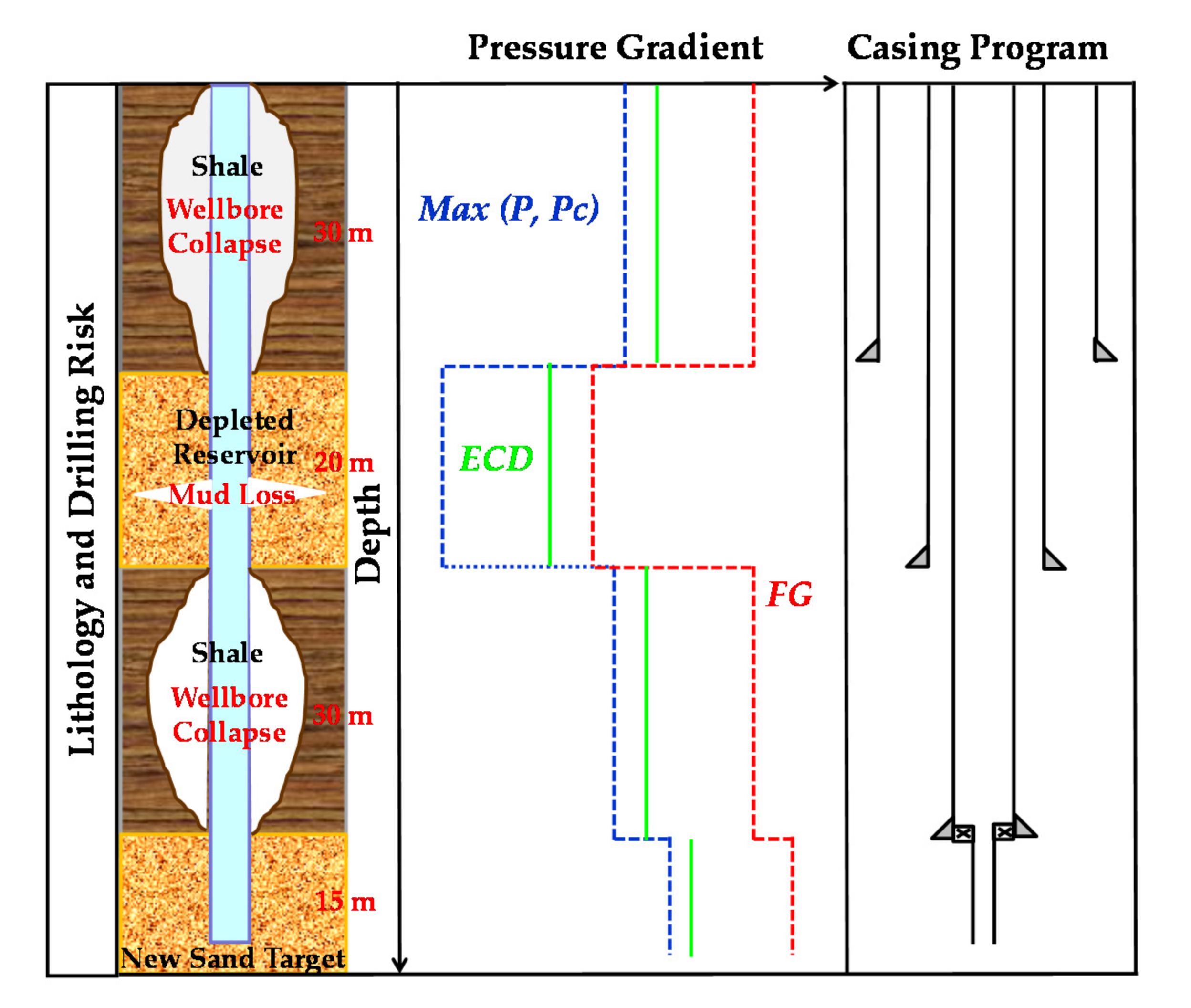
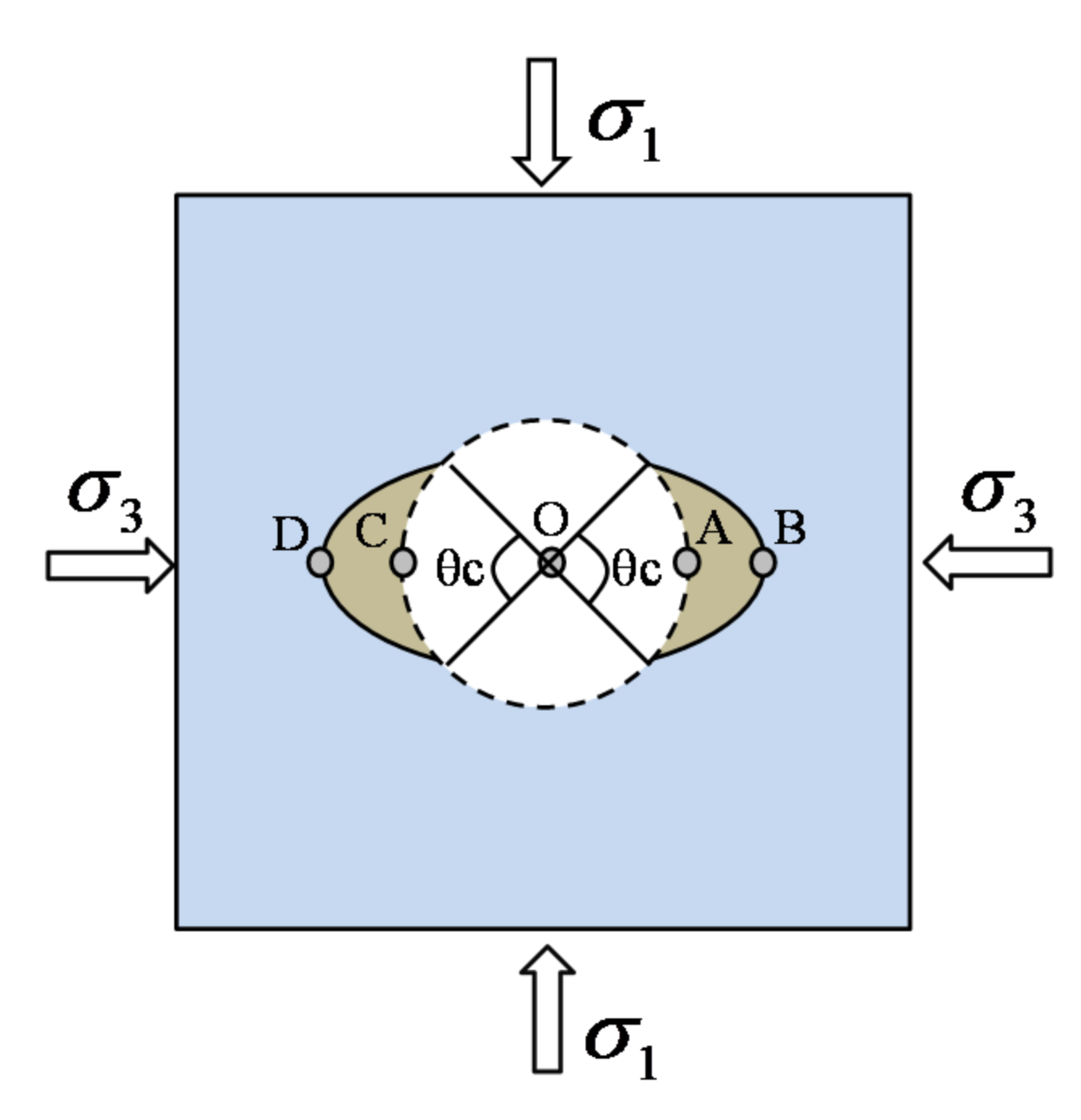
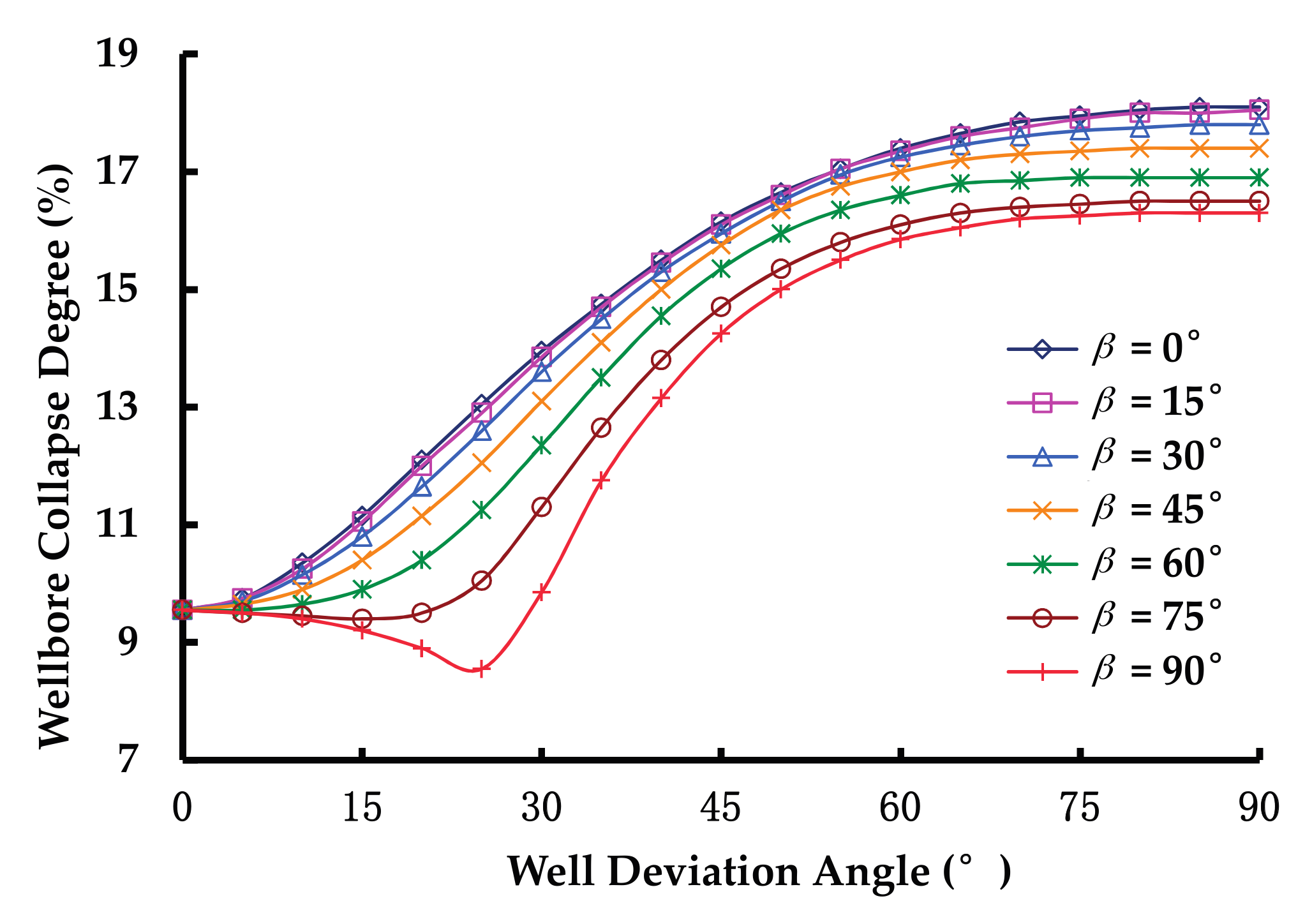

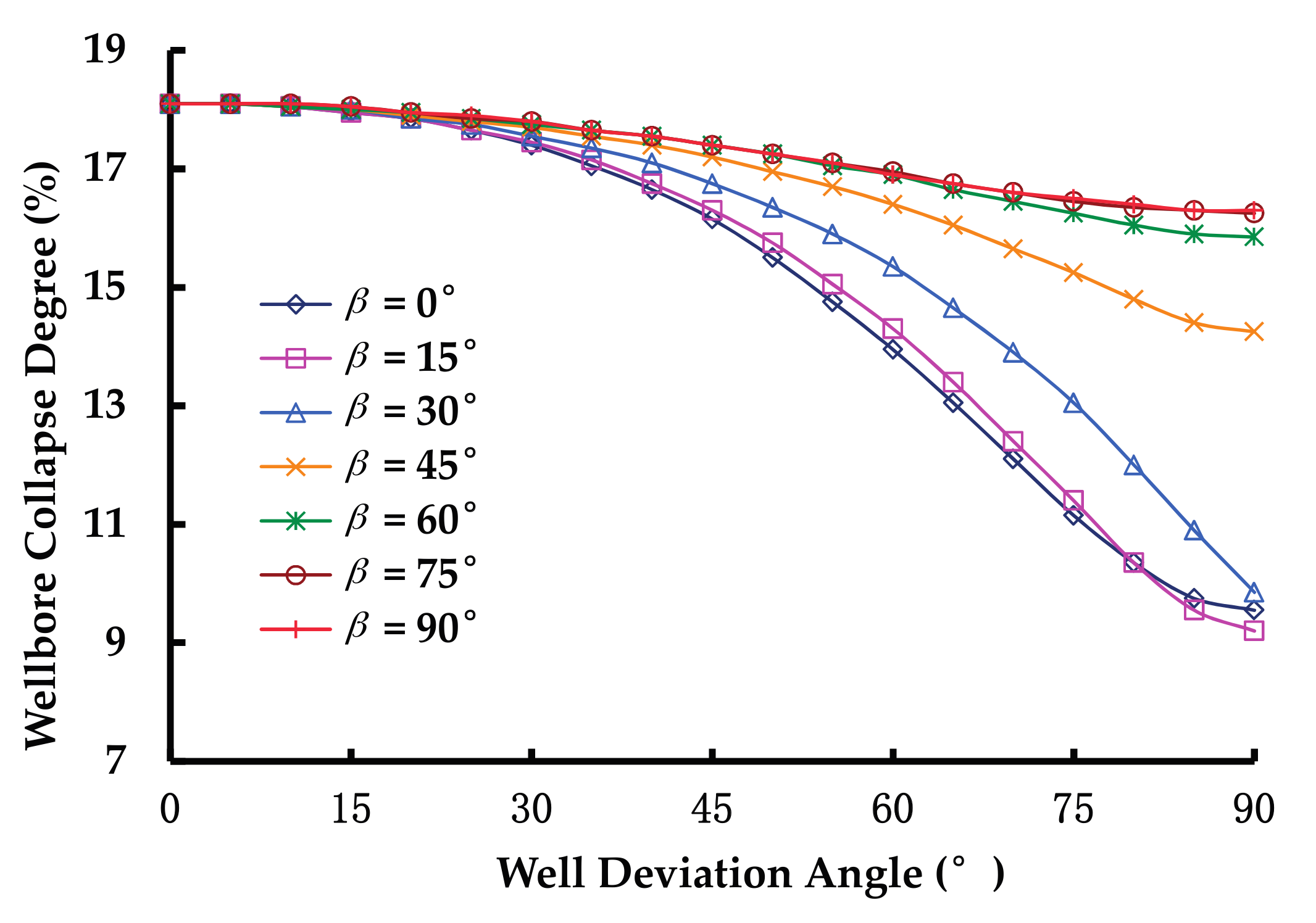

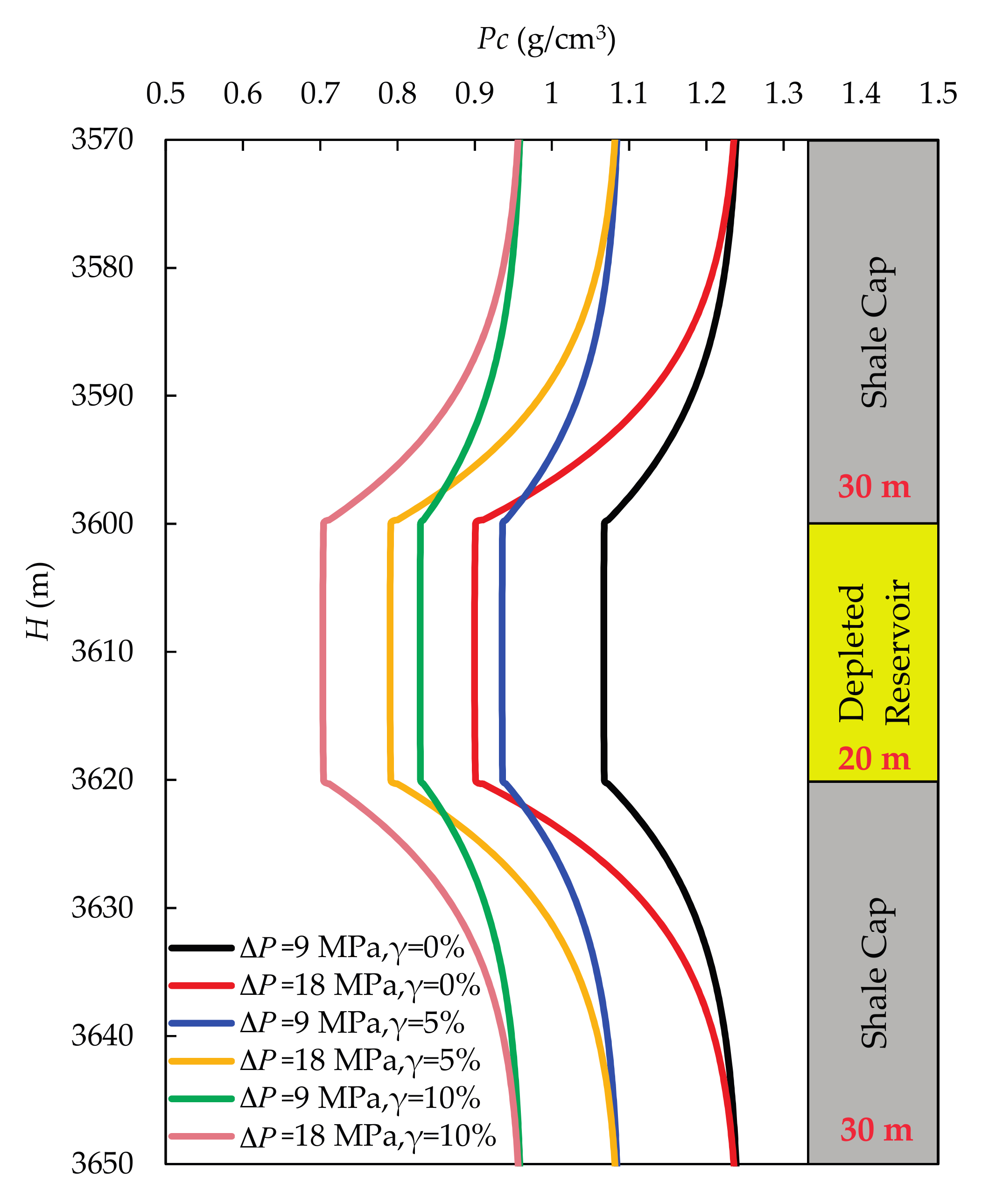

© 2017 by the authors. Licensee MDPI, Basel, Switzerland. This article is an open access article distributed under the terms and conditions of the Creative Commons Attribution (CC BY) license (http://creativecommons.org/licenses/by/4.0/).
Share and Cite
Zhao, K.; Han, J.; Dou, L.; Feng, Y. Moderate Collapse in a Shale Cap of a Nearly Depleted Reservoir. Energies 2017, 10, 1820. https://doi.org/10.3390/en10111820
Zhao K, Han J, Dou L, Feng Y. Moderate Collapse in a Shale Cap of a Nearly Depleted Reservoir. Energies. 2017; 10(11):1820. https://doi.org/10.3390/en10111820
Chicago/Turabian StyleZhao, Kai, Jiyong Han, Liangbin Dou, and Yongcun Feng. 2017. "Moderate Collapse in a Shale Cap of a Nearly Depleted Reservoir" Energies 10, no. 11: 1820. https://doi.org/10.3390/en10111820
APA StyleZhao, K., Han, J., Dou, L., & Feng, Y. (2017). Moderate Collapse in a Shale Cap of a Nearly Depleted Reservoir. Energies, 10(11), 1820. https://doi.org/10.3390/en10111820





